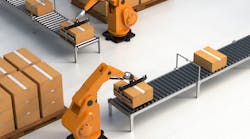Wouldn’t it be nice if a single machine could solve all your operational challenges?
Though a lot of modern equipment available on the market today can come pretty close, the assumption that a single tool can be a cure-all is an unrealistic one. Automation and robotics have become indispensable in modern manufacturing and warehousing, driving efficiency, productivity and cost savings. But with so many variables in play, it can be overwhelming to determine where to start.
The easiest way would arguably be to implement a full end-of-line solution with automation components, which would offer the flexibility, scalability and redundancy needed to improve productivity. Realistically, though, budget plays a significant role in line equipment improvements. For manufacturers interested in automation but hesitant due to budget considerations, palletizers can serve as a cost-effective and straightforward introduction. Full system integrations should also be considered as an alternative to single automation investments, as the push to reduce labor continues to be a priority, even on a small scale.
Why is this? Let’s look at the trends driving adoption of palletizers.
Today’s culture of rapid fulfillment has pushed many manufacturers out of their comfort zones. With the number one goal to ship as much as possible as fast as possible, the evolving dynamic of mixed pallet loads has forced manufacturers to think outside the box to keep up with demand. Manual palletizing, predominant in many mid-range operations and distribution centers, carries limitations—it is time-consuming, labor-intensive, and error-prone, leading to inconsistencies and increased risk of load instability and damaged products during transit. Not to mention the liability and risk of injury to the workers doing this repetitive task.
By removing the manual aspect of palletizing, manufacturers can refocus their attention on the root goal—creating an efficient process that produces the highest throughput as quickly as possible. Implementing a core palletizing solution helps address another struggle across many industries: the ongoing labor shortage.
Labor challenges, including higher wages, turnover and manual inconsistencies, have prompted many manufacturers to look toward automation to fill the resulting gaps in the production line.
Modern manufacturing emphasizes customization and real-time diagnostics to optimize performance. Developing an overall system solution that leverages intrinsic knowledge of other components throughout the entire production line is key to achieving maximum efficiency.
Real-time diagnostics enable continuous monitoring and adjustments, ensuring the palletizer performs at its best and adapts to changing production requirements. This level of customization and adaptability allows for seamless integration into existing systems and processes, further enhancing the overall automation strategy.
To keep up with the growing demand for palletizers, there has been a notable shift toward pre-wired systems to improve installation timeframes and minimize downtime. With advanced software and robust equipment, robotic palletizers have become a versatile solution for operations with multiple SKUs requiring variable stacking patterns. The varying speed capabilities of these machines and customizable intuitive interfaces make them a suitable option for high-volume production lines.
Selecting the Right Palletizer
It’s important to note that not all palletizing solutions are created equal, and careful consideration is required for optimized performance and longevity. Several factors must be taken into consideration when choosing to upgrade or integrate new equipment.
Selecting the right palletizer involves careful consideration of factors such as Overall Equipment Efficiency (OEE), as well as the ability to handle cases out of specification or damaged pallets. It is essential to evaluate the product history and determine whether a single tool or a combination of tools is needed. Working with an OEM that has a deep bench of engineers with extensive industry experience can help reduce the stress of this often-confusing process. This consultative approach allows for tailored solutions based on modified standards and customized tooling to meet specific requirements.
Adjustability and versatility of the software and tooling are also critical, as varying product types may require different handling methods. While integrated systems can have multiple robots in tandem to form layers and move pallets, it’s worth considering that more automated tasks introduce more potential points of failure. This is where the benefit of pre-installation testing comes into play.
By replicating real-world transit conditions in a controlled setting, users can learn how their specific product can be packaged and shipped more efficiently and cost-effectively. Finding a transit packaging partner who offers this through an ITSA-certified testing lab can help manufacturers verify opportunities for automation before investing in and implementing them across their operations.
Once a palletizer—or any new machine—has been integrated into the production line, it’s important to be sure it’s regularly maintained and serviced promptly when necessary. An OEM with a team dedicated to post-installation service and support can help keep your equipment operating at peak performance, minimizing downtime and keeping operations running smoothly.
Empowering manufacturers and warehouses to enhance their operations, palletizers have emerged as a strong introductory option to the world of automation. The next generation of manufacturing innovation is upon us, and it’s crucial to recognize the increasing role that automation and robotics will play in improving efficiency, productivity and cost-effectiveness.
While the transition to automation can seem overwhelming, partnering with a transit packaging leader can simplify the process. By focusing on specific pain points and implementing targeted solutions, businesses can reap significant benefits and gain a competitive edge in their respective industries.
Shawn Semer is director of sales and marketing for Signode’s Global Automation division. Signode is a manufacturer of automated packaging equipment, tools and consumables. Semer holds a degree in Mechanical Engineering from Goshan College.



